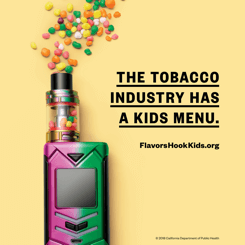April 29, 2018
Yvette van der Eijk, Stella Bialous and I just published "The Tobacco Industry and Children’s Rights" in Pediatrics.
Here is the UCSF press release on the paper:
UNICEF “Muted” on Tobacco Control for Children
UCSF Paper Shows Big Tobacco Influenced Humanitarian Children’s Rights Agency
The tobacco industry manipulated the renowned children’s rights agency UNICEF for more than a dozen years, from 2003 until at least 2016, during which time UNICEF’s focus on children’s rights to a tobacco-free life was reduced, according to previously secret documents uncovered by UC San Francisco.
The research appears April 30, 2018, in Pediatrics, the journal of the American Academy of Pediatrics.
April 28, 2018
The latest campaign finance statements are out and RJ Reynolds continues to be the sole financer of “No on E”, the referendum campaign to overturn San Francisco’s prohibition on the sale of flavored tobacco products, with $9,041,824. They are saturating people’s mailboxes with mailers touting freedom, government overreach, and crime, the industry’s longstanding arguments against everything. You can read this on the No on E website. Of course, they never mention their true motivation: RJR wants to protect its sales of menthol and other flavored tobacco products.
For a trip down memory lane, watch these videos of old tobacco industry political ads from 1978 (Proposition 5), 1980 (Proposition 10), 1982 (Kern County Proposition A), and 1983 (San Francisco Proposition P, at about 20 minutes into the video) where the industry was trying to block smoking restrictions. While the tobacco industry did defeat smoking restrictions in 1978 and 1980, by 1983 voters in San Francisco saw through their arguments and upheld San Francisco’s smoking restriction law. (I don’t know the outcome of Prop A.)
April 26, 2018
It’s bad enough that e-cigarettes are a strong gateway to cigarette smoking, including stimulating kids who are experimenting with cigarettes to become established smokers, but now there is evidence that, like cigarettes, they are a gateway for marijuana.
Hongying Dai and colleagues used the FDA PATH study to examine the association between e-cigarette (and cigarette) use at baseline with marijuana use one year later among kids who had never used marijuana at baseline. In their paper “Electronic cigarettes and future marijuana use: A longitudinal study” published in Pediatrics they find that any e-cigarette use at baseline about doubles the odds of using marijuana a year later.
The effects of smoking cigarettes at baseline is an independent effect with about the same magnitude.
The impact on younger kids was bigger.
We found a similar independent of marijuana use on cigarette smoking initiation in our study of the effects of youth initiating with any non-cigarette product (including e-cigarettes).
Dai and collagues have an interesting comment on what may be causing this effect:
April 26, 2018
Ken Warner and David Mendez recently published another population model to estimate the public health effects of the advent of e-cigarettes, “E-cigarettes: Comparing the Possible Risks of Increasing Smoking Initiation with the Potential Benefits of Increasing Smoking Cessation,” in Nicotine and Tobacco Research. In contrast to several (but not all) earlier models, they found population benefits, “[w]ith base-case assumptions, the population gains almost 3.3 million life-years by 2070.”
The question several people have asked me, is why such different conclusions?
Most of these models are generally structured to project the effects of e-cigarettes over time as the population ages and people enter and leave the tobacco market by starting to use tobacco, stopping using tobacco, or dying. (The one Sara Kalkhoran and I developed is a steady state model at equilibrium.) While there are some differences in how people to this, these differences do not explain the different outcomes.
April 24, 2018
There has been growing public concern about the explosive growth of flavored tobacco products, particularly the explosive growth of JUUL e-cigarettes among kids.
Public health responded today on both coasts.
 The California Department of Public Health launched a brilliant (and colorful) educational effort on the impact of flavored tobacco products on kids. You can see the TV ads on “the tobacco industry’s kids menu” here. At least two of the ads, Fruit Candy and Bedroom feature JUUL. The accompanying web page https://www.flavorshookkids.org/ gives loads of great information and shows the print ads.
The California Department of Public Health launched a brilliant (and colorful) educational effort on the impact of flavored tobacco products on kids. You can see the TV ads on “the tobacco industry’s kids menu” here. At least two of the ads, Fruit Candy and Bedroom feature JUUL. The accompanying web page https://www.flavorshookkids.org/ gives loads of great information and shows the print ads.
I never cease to be amazed at how talented CDPH and their ad agency Duncan Channon are at taking complicated science and tobacco industry behavior and boiling them down to compelling messages that people can understand.
